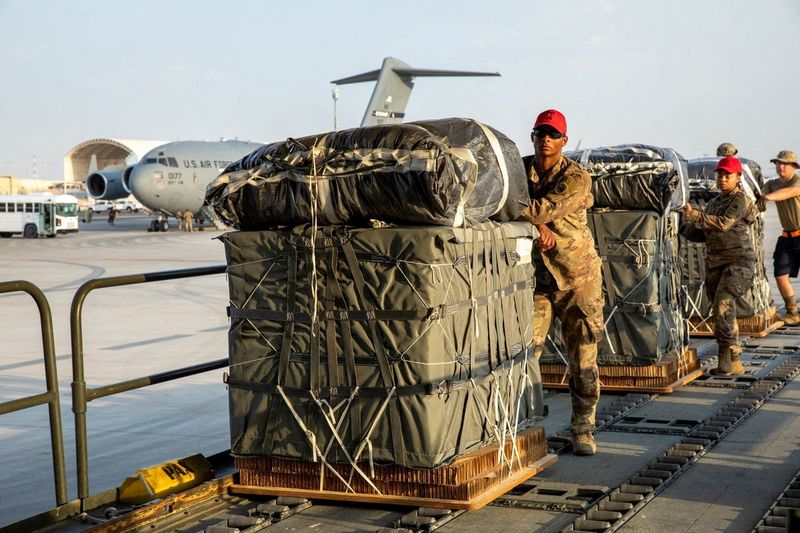
©Reuters. FILE PHOTO: Members of the U.S. Air Force work to prepare a delivery of humanitarian aid for Gaza residents, in this image released March 5, 2024. U.S. Central Command via X/Handout via REUTERS/File Photo
By Phil Stewart and Michelle Nichols
WASHINGTON (Reuters) – U.S. President Joe Biden’s plan to build a floating U.S. military port to speed aid to Gaza could take up to 60 days to become reality and involve more than 1,000 American troops, the Pentagon said on Friday.
The Pentagon offered the timeline a day after Biden announced the initiative in his State of the Union address, as he sought to calm anger in his Democratic Party over his staunch support for Israel’s offensive in Gaza since Oct. 7.
The United Nations has warned that widespread famine in the Gaza Strip is “almost inevitable” without urgent action. The formal conclusion that famine has arrived in the coastal enclave of 2.3 million people could come next week. The UN has said that once famine is declared, it is too late to help many people.
“Gaza’s children can’t wait to eat. They are already dying of malnutrition and saving their lives is a matter of hours or days, not weeks,” said Jason Lee of Save the Children.
Some U.S. lawmakers and aid organizations have said the floating dock system masks the larger problem: the Israeli government’s failure to allow more aid to enter Gaza by land, which is the fastest and most efficient option.
“This is not a logistical problem; it’s a political problem,” said Avril Benoît, executive director of Doctors Without Borders in the United States.
“Rather than turning to the US military for an alternative solution, the United States should insist on immediate humanitarian access using the roads and entry points that already exist.”
PLANNING STILL IN THE INITIAL PHASES
Air Force Major General Patrick Ryder, the Pentagon’s chief spokesman, described planning for the port system as still in its early stages, with deployment orders just starting to go out to troops heading to the Middle East.
The Pentagon said it had not yet determined exactly how the floating port system’s landing site would be protected from any threats and said it was in talks with partners including Israel.
Asked whether the Pentagon had anticipated that the port system would be targeted by the Palestinian militant group Hamas, which the United States calls a terrorist organization, Ryder said: “That’s certainly a risk.”
“But if Hamas truly cares about the Palestinian people, then, once again, hopefully this international mission to provide aid to people who need it can go ahead unhindered,” Ryder said. However, in a sign that security is a concern, Ryder said no American troops will enter Gaza, even temporarily, to complete construction of the port.
The U.S. port system planned for Gaza has two separate components, the first being the construction of an offshore floating barge capable of accepting aid deliveries.
The U.S. military would then move aid from there onto a 550-meter-long floating causeway anchored to the shore.
Once operational, the port system will enable the delivery of about 2 million daily meals to Gazans, Ryder said.
By comparison, the U.S. military delivered a total of about 124,000 meals during four airdrops in the past week. The latest airdrop on Friday delivered about 11,500 meals, the U.S. military said.
CRITICISM FROM REPUBLICANS
Asked about social media reports Thursday that some U.S.-launched aid had killed people on landing, Ryder said the United States was confident that no U.S.-launched aid had caused casualties. She noted that Thursday’s casualty reports surfaced five minutes before Thursday’s launch occurred.
While many of Biden’s Democratic allies applaud the aid push, some Republican lawmakers have criticized it.
“Building a port in Gaza means building a port for Hamas,” Republican Senator Marco Rubio wrote in X.
UN aid chief Martin Griffiths on Friday described the UN’s role in the US plan as “currently limited”.
He said he had been contacted Thursday by the U.S. mission to the United Nations to say that Washington would work with the United Nations and that U.N. officials in the region had spoken to the United States on Friday, including the U.S. military’s Central Command.
“It’s the start of a conversation … it’s going to be difficult to get it up and running quickly,” Griffiths told reporters on Friday. “But we need help wherever we can get it.”
“What we need for Gaza is obviously an immediate ceasefire, but we also need land routes. Access to land is our main one, that’s where you get scale,” Griffiths said.